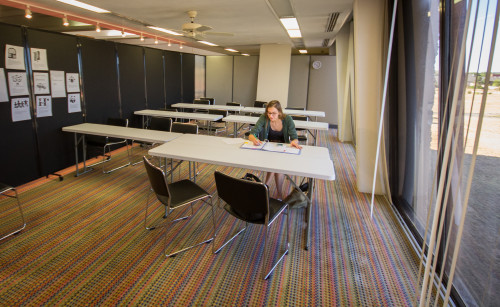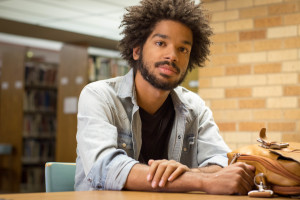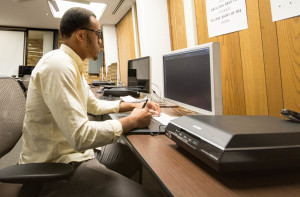Tags
Related Posts
Share This
Graphic/Design Adjusts

Student Sara Traband uses the newly added classrooms in the Graphic Design Department. Photo by Jason Stilgebouer.
This semester has brought big changes to both the Graphic Design and Digital Art departments at SFUAD. The departmental changes include new leadership and full-time faculty members, but perhaps the biggest change of all is the movement of the Graphic Design and Digital Art programs from Alexis Hall to upstairs in Fogelson library. These changes were triggered by a desire for more professional application to the departments, and their growing size.
“The new space affords more engaged and interactive classrooms, which also mirror professional studios/offices,” says Linda Swanson, the dean of the School of Visual and Communication Arts. “I think that is exciting for most of the faculty and students, and of course, there are challenges in the transition also, such as lab access, which is no longer 24 hours.”
The lab hours are now Monday through Thursday from 3 to 11 p.m. in the library and Saturdays from 6 p.m. to 2 a.m. in Onate Hall. The new hours have been a difficult shift for some students, such as Graphic Design student Laura San Roman.
“My main struggle has been with the lab hours,” Roman says. “We have now one third of the lab hours we had last year. I didn’t use the lab exclusively for homework. I am one of those people who can’t be doing nothing for an hour.”
Julian Williams, a junior in the Graphic Design program, echoes Roman’s concerns about lab hours. Williams works a part-time job and is worried that his work schedule and the hours available may not always match up. However, Williams’ greater concerns are born out of his desire to keep what he calls “Alexis culture”: a community of students who communicate and constantly offer each other critique. Williams is eager to see this continue.
“I definitely want that culture and that idea of us working off one another to stay alive,” says Williams, “And I definitely think without us being able to be in the lab as much as we want to, that isn’t being made as possible as it could be.”
Despite the early frustrations of many students regarding this adjustment, others find the changes refreshing and see themselves as more obligated to manage their time.
“Overall I like the changes,” says Chimezie Onuoha, a senior in the Digital Arts program. “The lab hours aren’t the best, but it really helps us to stay focused. It makes you appreciate the ability to even have a lab.”
Alexandra Conkins, Onuoha’s Digital Arts peer, agrees, saying, “I prefer to work on assignments later into the night, which is what made me so much of a night owl last semester, but in knowing my goals for the new semester and that the lab time is now limited, it pushes me to have a more ideal work ethic.”
Conkins went on to say that she sees “a strong sense of drive” from other students in the atmosphere, and that this encouragement motivates her to create new work of her own.
Overall, the departmental changes are an obstacle to be overcome for some students, but seem to provide a more professional workspace for others—an opportunity to experience the type of workspace which students might encounter in their career paths.
“When I walk up the stairs at Fogelson, I hear the buzz of discussion and there is starting to be more visibility of work,” says Swanson, “But this is a work in progress, as all departments and programs are. If you provide the conditions for community and engagement, that will result in meaningful conversations and those conversations will become the fabric of the department.”









 Jackalope Magazine is the student magazine of Santa Fe University of Art and Design. Building on the interdisciplinary nature of our education, we aim to showcase the talent of our university and character of our city.
Jackalope Magazine is the student magazine of Santa Fe University of Art and Design. Building on the interdisciplinary nature of our education, we aim to showcase the talent of our university and character of our city.
Recent Comments